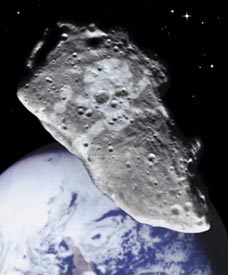
Near-Earth asteroids pose a threat to our planet.
S&T illustration by Steven Simpson.
Billed as the "blind-spot" asteroid, a building-size space rock passed the Earth unnoticed two weeks ago. An automated sky survey detected minor planet 2002 EM7 on March 12th. Subsequent orbital calculations determined that the asteroid had come closest to the Earth four days earlier at a distance of about 464,000 kilometers (288,000 miles), slightly more than the distance from the Earth to the Moon. Prior to the flyby, 2002 EM7 was too close to the Sun, hence the "blind-spot" moniker.
When the close call was made public, it raised considerable concern. Researchers estimated the object to be about 50 to 70 meters across, thought to be a little smaller than the object that exploded over the Tunguska River region of Siberia in 1908 and flattened thousands of square kilometers of forest. A Tunguska explosion over a populated area would undoubtedly cause incredible damage.
Despite the media attention in the wake of 2002 EM7's passage, such "close" flybys are not uncommon. According to Jim Scotti (University of Arizona), "Simply put, objects the size of the Tunguska impactor pass within the distance that 2002 EM7 did about 25 times every year." Rocks the size of 2002 EM7 come by nearly 100 times a year. This particular instance grabbed headlines because the minor planet was actually observed. Scotti explains that astronomers cannot fully tally asteroids about 50 m in diameter using today's survey techniques, regardless of whether the objects are moving from the direction of the Sun or not. Alas, this is of little solace to people worried about space-borne threats.

 0
0
Comments
You must be logged in to post a comment.